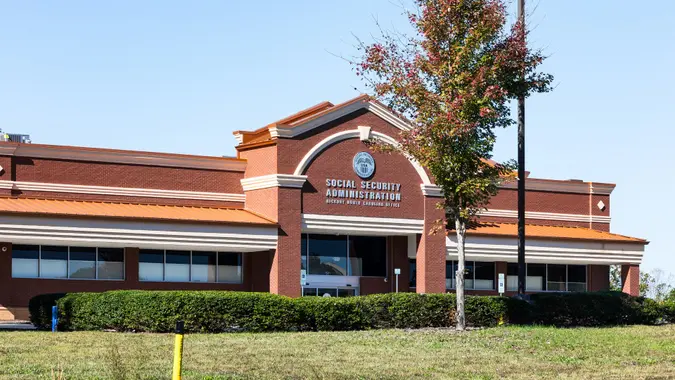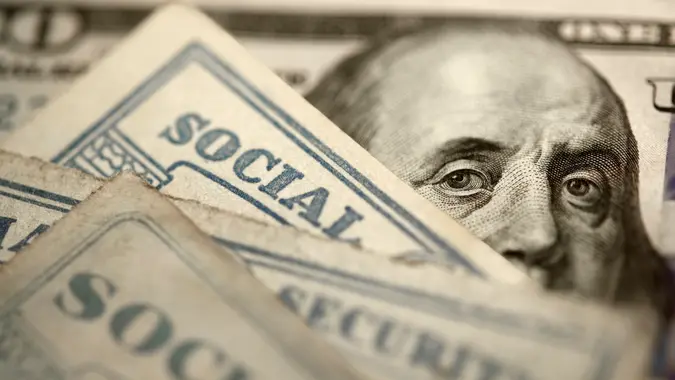Tony Robbins: Here’s What Is Hurting Your 401(k) More Than the Economy

Commitment to Our Readers
GOBankingRates' editorial team is committed to bringing you unbiased reviews and information. We use data-driven methodologies to evaluate financial products and services - our reviews and ratings are not influenced by advertisers. You can read more about our editorial guidelines and our products and services review methodology.

20 Years
Helping You Live Richer

Reviewed
by Experts

Trusted by
Millions of Readers
Famed life coach and entrepreneur Tony Robbins is concerned that a hidden enemy is killing your retirement’s 401(k) plan. If you guessed high fees over economic volatility, then you and Robbins are aligned in your financial literacy.
Robbins takes issue with the fact that the entire 401(k) industry is reluctant to be fully transparent about the effect high fees have on 401(k) plans, and not much is being done about it. As Robbins said, “For 30 years, the industry did not even have to tell investors what they were charging. A few years ago, the law changed, and now you get a 35- to 50-page disclosure document that — if you’re a lawyer or you have a degree in finance — maybe you can understand.”
Because of all this, Robbins stresses that investors must take their retirement savings plan matters into their own hands — especially once they hit age 50. Here are some of the steps Robbins suggests, along with others you can use to help protect your retirement nest egg from the hidden fees that might be killing it.
Know Your Costs
According to Robbins, a majority of Americans think they aren’t paying anything in terms of 401(k) fees, and almost all of them don’t have a grasp on the actual costs. As the saying goes, you can’t fix something unless you know what’s broken, so take the time to learn just how much of a drag your 401(k) fees are on your tax-advantaged retirement account.
You should have been provided with information like this when you opened your account, and subsequently every year thereafter. However, since you likely don’t have that information at your fingertips, call your 401(k) administrator or primary source in human resources the first chance you get. Ask for a printout of all account and management fees, which they must legally provide to you.
Understand the Math
Some investors might hear that their 401(k) fees are 1.5% per year and say, “Well, that doesn’t sound like that much — it’s only $100 for every $10,000 I have invested.” While mathematically true, it doesn’t tell the whole story. According to Robbins, cutting fees by just 1%, say from 1.5% to 0.5%, can make your retirement nest egg last a full decade longer.
Statistics from the Department of Labor support Robbins’ assertion about the huge effect fees have on account balances. Here’s a scenario outlined by the DOL:
- Imagine you’re 30 years old, planning to retire at 65 and have a current 401(k) account balance of $25,000. If you average a 7% return annually on your investments and expenses reduce your average returns by 0.5%, your account balance will grow to $227,000 at retirement, if you don’t add any additional funds.
- However, if fees and expenses are 1.5%, your 401(k) will grow to only $163,000. What this means is a 1% difference in fees and expenses would reduce your account balance at retirement by a whopping 28%.
This is why it’s so important to keep an eye on 401(k) plan fees companies or employers offer. You probably wouldn’t willingly give up 28% of your 401(k) balance — at least, you shouldn’t — so be diligent in knocking out that 1% in fees in your 401(k) plan, if possible.
Invest Outside of Your 401(k) Plan
While your 401(k) can be a great investment — particularly if you get a large employer match — it’s not the only game in town. You’re completely free to invest additional money outside of your 401(k), and if you’ve maxed out your 401(k) and can afford to save more, then you should.
While regular investment accounts don’t have the tax benefits of 401(k) plans, they also have fewer restrictions. For example, you can add as much money as you want to a regular investment account, and you can make withdrawals whenever you would like.
You can also choose to invest in almost any type of security, from stocks and bonds to mutual funds, ETFs, commodities and more. Within most 401(k) plans — but not all — you’re generally offered a limited menu of mutual funds and/or ETFs.
Final Take To GO
Robbins asserts that 401(k) fees are unnecessarily dragging down your potential returns and investment gains, and he’s backed up by calculations from the U.S. Department of Labor. However, it’s also important to note that, as the DOL points out, fees are not the only consideration when it comes to 401(k) plans, and they shouldn’t be considered in a vacuum.
Outstanding performance or service levels, for instance, may justify slightly higher fees for not only 401(k) plans but also individual retirement accounts. However, all other factors being equal, the lower you can make your 401(k) fees, the better you may end up in the long run.
Caitlyn Moorhead contributed to the reporting for this article.
More From GOBankingRates
 Written by
Written by  Edited by
Edited by 

























